Abstract
In recent times, groundwater has emerged as an alternative drinking water source for populations in Ghana’s gold mining communities due to high pollution levels in surface water resources caused by artisanal miners. This study presents the findings on different radioactivity levels in groundwater, their sources, the characteristics of aquifers in the study area, and the impact of radionuclides on human health as a factor of water quality. The mean activity concentrations of radionuclides in groundwater samples were 0.1 ± 0.04 Bq/L for Ra-226, 0.36 ± 0.05 Bq/L for Ra-228, and 1.41 ± 0.10 Bq/L for K-40. The activity concentration of 228Ra exceeded the World Health Organization (WHO) guideline level of 0.1 Bq/L. The elevated levels of Ra-228 in groundwater were found to be of natural origin, emanating from the aquifer rocks in the study area. Groundwater resources near mining zones showed higher radioactivity levels. The corresponding committed effective dose from consuming such groundwater was estimated to be higher than the United Nations Scientific Committee on the Effects of Atomic Radiation (UNSCEAR) recommended value of 0.3 mSv/y for children and infants, indicating potential health risks.
1. Introduction
Water is an essential resource to sustain life and society [1]. The growth of the global population has led to a sharp increase in water demand in recent decades [2,3]. Groundwater is a geologic agent that interacts with its environment. It can mobilize, transport, and accumulate matter—among these are also radioactive elements [4,5,6]. Studies have shown that groundwater may contain appreciable quantities of radionuclides. These radionuclides can enter groundwater as a result of water–rock interaction, resulting in radiation exposure to users [7]. Groundwater as a source of drinking water may contain radioactivity that could present a risk to human health [8]. Hence, there is growing recognition in many countries that natural radioactivity is a factor limiting the quality of groundwater supplies [1], as almost all the radionuclides detected in drinking water are of natural origin [4].
The radioactivity in groundwater mainly comes from radionuclides of the natural decay chains U-238 and Th-232, and K-40 in soil and bedrock. These are major sources of external gamma radiation arising from terrestrial radionuclides present at trace levels in all ground formations [3,8,9,10]. The radioactivity due to natural radionuclides in rocks and water is the main source of human exposure to background radiation. The occurrence of natural radionuclides in drinking water poses a health hazard when ingested due to their ability to accumulate in various organs of the body [11,12,13]. Therefore, radiological characterization is an important part of drinking water monitoring due to the relatively high radiotoxicity of some naturally occurring radionuclides and their importance in the study of cumulative radiation effects on human health [9].
Globally, about 25–40% of the world’s drinking water is sourced from groundwater [4,14]. Groundwater is widely regarded as an essential water resource for human consumption and irrigation [15]. In Ghana, people rely on groundwater for drinking and other domestic purposes. In some parts of the country, groundwater is used to irrigate farms. The supply of good-quality water in rural communities is a major challenge [16]. Though the country is endowed with water resources, mainly surface water, the availability of water varies significantly in different seasons and from year to year. Likewise, the distribution of water supplies is not uniform, as the southwestern part of Ghana has more access to water than the coastal and northern parts [17]. In general, access to safe water is higher in urban areas compared to rural areas. Meanwhile, the majority of the population lives in rural areas, where agriculture is the main occupation [15]. In rural areas, water supplies are mostly obtained from groundwater resources. As of 2011, there were an estimated 75,000 dugouts, wells, and boreholes nationwide [17]. Studies in Ghana over the years have pointed out that the quality of groundwater in the country is generally good for multipurpose usage [15]. Nonetheless, this general assessment does not factor in the radionuclide contents in the groundwater resources. Groundwater quality is of interest in this study since surface waters in many mining areas in the country have become polluted with mine wastes due to increasing illegal mining activities [18,19].
In this study, the area is characterized by several artisanal mining activities, which, to a large extent, are unregulated, as seen in other parts of the country [18,20,21]. Mining provides employment and supports the livelihood of the inhabitants of the communities. However, it has led to the pollution of surface water resources [18,19,22], which serve as the source of drinking water for the inhabitants of the area. As a result of the pollution, inhabitants are resorting to groundwater as an alternative source of water for drinking and household use. Studies have shown that mining can result in the leaching of radionuclides into groundwater resources, hence causing further pollution of groundwater resources with radionuclides as more fractures are developed in bedrocks due to mining activities [3,5,6,7,10,23]. Since groundwater resources can contain significant concentrations of radionuclides [8], this study seeks to determine the quality of such groundwater resources and whether they are potable for drinking and domestic use by the population of Atiwa West. Unfortunately, no studies have yet been published on the levels of radionuclides in groundwater resources in the study area and, consequently, their suitability for human use. This work sought to assess the levels of natural radionuclides in groundwater in the area, evaluate the potability of the groundwater for domestic and drinking needs as well as for agricultural purposes, and contribute to the database of groundwater quality in the eastern part of Ghana.
Atiwa West has several sources of water for domestic use, including rivers, streams, and groundwater. Previous studies conducted on radionuclides in groundwater in mining areas in other countries have established that mining activities, such as crushing and washing of ore, discharge and leaching of tailings, and transportation of ore minerals, are found to increase the levels of radionuclides Ra-226, Ra-228, and K-40 [11,12,23]. However, in our study area, radionuclide contamination in groundwater due to these activities has not yet been investigated to determine the quality of groundwater in the area. As a result, there is a general lack of knowledge among the public and miners on the radiological effect of drinking groundwater containing high levels of radionuclides.
Hence, the aims of this study were to determine the activity concentrations of Ra-226, Ra-228, and K-40 in groundwater resources in the mining towns of Atiwa West District, Ghana, to identify the source of radionuclide contamination using the isotopic ratio and to provide information about the radiological risks resulting from the ingestion of these radionuclides with respect to using the water containing them for drinking.
2. Materials and Methods
2.1. Study Area
The study area, Atiwa West District (Figure 1), is in the Eastern Region of Ghana, lying between 6°18′50.4″ N and 0°35′34.2″ W. It has an elevation of 240 m to 750 m above sea level. The region is largely green as it is located within a semi-deciduous forest. Twelve to twenty percent of the land area is covered with commercial tree species such as Milicia regia, Triplochiton scleroxylon, Terminalia superba, Mahogany, and bamboo [15,24,25]. The landscape is gentle and undulating, with different rock formations resulting in its different relief features, ranging from flat bottom valleys to steep-sided high lands. With a population of about 62,000, the inhabitants are mainly into agriculture and agro-based industrial activities. The area has mineral deposits, particularly gold, which has made the area one of the hot spots for artisanal gold mining activities in the region [24,25,26,27]. The artisanal mining activities in the study area are mostly located very near farmlands, water resources, and residential areas.
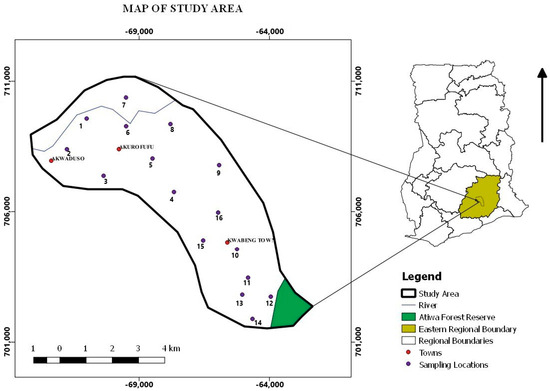
Figure 1.
Map of study area.
2.2. Sampling
In this study, groundwater sampling was conducted based on the proximity of the groundwater resources to mining areas. Samples were collected from 16 different locations within the study area, utilizing composite samples of triplicates from each location. A total of 48 groundwater samples were gathered. The samples were directly collected from boreholes and wells into pre-conditioned 1.5 L polyethylene bottles. Prior to filling, the bottles were rinsed with some of the groundwater. The samples were stored in polyethylene bottles and then acidified to prevent radionuclide precipitation and adsorption on the container walls. They were subsequently transported to the laboratory for further analysis [23].
2.3. Radioactivity Measurement
In the laboratory, the groundwater samples were transferred into pre-cleaned Marinelli beakers and sealed for a period of 4 weeks. This allowed for the establishment of secular equilibrium between the parent and daughter radionuclides before counting with a gamma spectrometer. The counting time for each sample was approximately 22 h, ensuring better statistics in the gamma spectra with minimal counting error. The activity concentrations of Ra-226, Ra-228, and K-40 were measured using a High Purity Germanium (HPGe) detector. This equipment was employed to count and detect Ra-226, Ra-228, and K-40 in all the samples. The detector has an efficiency of 40% and is cooled to a liquid nitrogen temperature of −196 °C. It was calibrated with three closed sources: Cs-137 (at 662 keV), Co-60 (at 1173 and 1332 keV), and Am-241 (at 59 keV). Activity concentrations of the radionuclides were determined using specific gamma peaks: for Ra-226, using its decay products peak energies of Pb-214 at 351 keV and Bi-214 at 609 keV; for Ra-228, using Ac-228 and Tl-208 at 911 keV and 583 keV, respectively; and K-40 was determined at a peak energy of 1460 keV [28].
2.4. Radionuclides Activity Concentration
The specific activity concentration of Ra-226, Ra-228, and K-40 in the groundwater samples were determined by the following equation:
where A is the activity concentration of Ra-226, Ra-228, and K-40 in Bq/L; N is the net area under the related energy peaks; Ɛ is the gamma efficiency at energy E; P represents the abundance of the gamma line of a radionuclide; v is the sample volume in liters; and t represents the counting time in seconds.
2.5. Statistical Analysis
The Statistical Package of Social Science (SPSS) tool, version 26, was used to analyze and describe the determined activity concentrations of Ra-226, Ra-228, and K-40 in the groundwater of Atiwa West. Normality tests were conducted by using the Kolmogorov–Smirnov and Shapiro–Wilk tests. The tool was used to determine ordinary statistics of the estimated activity concentrations. The data sets were evaluated for their mean, median, minimum, maximum, standard deviation, correlations, kurtosis, and skewness values.
2.6. Estimation of Health Hazards Due to Ingestion of Ra-226, Ra-228, and K-40 in Groundwater
The radiological hazard associated with the consumption of such groundwater was evaluated. The term “radiological hazard” refers to the risk posed by exposure to radioactive substances. In this context, it specifically pertains to the presence of harmful radioactive elements in the groundwater, attributed to the activity concentrations of Ra-226, Ra-228, and K-40. This hazard was quantified in terms of the committed effective dose and excess lifetime cancer risks. The committed effective dose due to the ingestion of radionuclides was determined using Equation (2).
where Eing (w) is the effective dose from the consumption of water in mSv/y; Asp (w) is the activity concentration of the radionuclides in a sample in Bq/L; Iw is the intake of water per year; and DCFing is the ingestion dose coefficient in Sv/Bq, i.e., 2.3 × 10−4 m Sv/Bq for Ra-226, 6.9 × 10−4 m Sv/Bq for Ra-228, and 6.2 × 10−6 m Sv/Bq for K-40. The annual water consumption rates adopted for the study were 730 L for adults, 350 L for children, and 250 L for infants [13,29].
The Lifetime cancer risk associated with the ingestion of radionuclides in groundwater was evaluated using the following equation:
where Eing is the committed effective dose in mSv/y, LE is the life expectancy rate of 70 years, and RF is the risk factor of 7.3 × 10−2 per Sv. The RF considers the risk regarding severe hereditary effects and fatal cancer (WHO, 2011). According to the International Commission on Radiological Protection (ICRP) (1990), multiplying RF by the reference dose level of 0.1 mSv/y in drinking water provides a likely upper bound reference level of approximately 10−4 for the lifetime risk of stochastic health effects [4,30].
Lifetime risk = Eing × LE × RF
3. Results
3.1. Activity Concentrations of Ra-226, Ra-228, and K-40 in Groundwater
Table 1 presents the basic descriptive statistics of the collected data, including the minimum, maximum, average, standard deviation, kurtosis, and skewness values. The activity concentrations of the measured natural radionuclides in the Atiwa West groundwater samples are depicted in Figure 2, Figure 3 and Figure 4. These figures illustrate the mean activities for each groundwater sampling location.

Table 1.
Descriptive statistics for the mean activity concentrations of Ra-226, Ra-228, and K-40 in groundwater in the Atiwa West district.
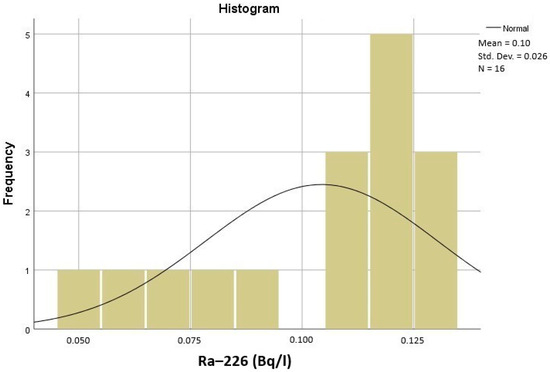
Figure 2.
Frequency of distribution of Ra-226 activity concentration in groundwater.
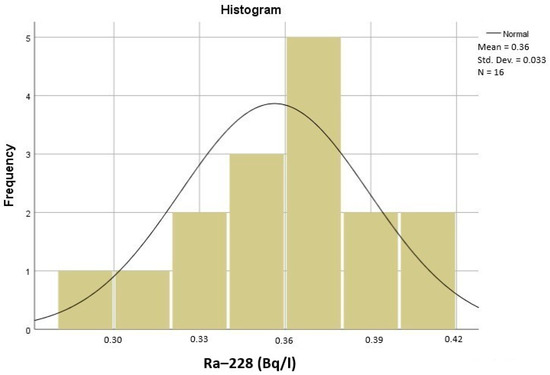
Figure 3.
Frequency of distribution of Ra-228 activity concentration in groundwater.
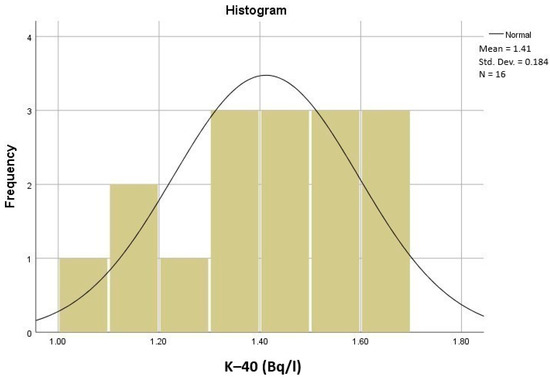
Figure 4.
Frequency of distribution of K-40 activity concentration in groundwater.
In Table 1, the activity concentration of Ra-226 ranged from 0.05 ± 0.03 to 0.13 ± 0.04 Bq/L, with a mean value of 0.1 ± 0.04 Bq/L. The measured activity concentrations of Ra-226 were lower than the World Health Organization (WHO) and UNSCEAR guideline levels of 1.0 Bq/L [13,29]. Based on kurtosis and skewness, the normality of the distribution for Ra-226 had negative values. Compared to the zero value of normal distribution, this suggests a tendency towards symmetric distribution. However, applying the Kolmogorov–Smirnov and Shapiro–Wilk normality tests indicated that Ra-226 activities are not normally distributed, as evidenced by p-values < 0.05. The frequency distribution of Ra-226 activity concentration is shown in Figure 2.
For Ra-228, concentrations ranged from 0.29 ± 0.04 to 0.41 ± 0.06 Bq/L, with a mean of 0.36 ± 0.05 Bq/L. The overall mean activity concentration of Ra-228 is above the WHO and UNSCEAR recommended levels of 0.1 Bq/L [13,29,31]. All measured activities at various sampling locations were also above 0.1 Bq/L, indicating that Ra-228 concentrations were higher than those of Ra-226 in the groundwater samples. The high Ra-228 activity concentration can be associated with a greater abundance of the parent radionuclide Th-232 than U-238 in the aquifer rocks [7]. The frequency distribution of Ra-228 activity concentration is presented in Figure 3. Relatively high negative skewness and kurtosis values suggest a distribution closer to normal. The Kolmogorov–Smirnov and Shapiro–Wilk normality tests also indicated that Ra-228 activity concentrations were normally distributed, with p-values of 0.20 and 0.91, respectively.
K-40 had activity concentrations ranging from 1.09 ± 0.10 to 1.65 ± 0.09 Bq/L, with a mean of 1.41 ± 0.10 Bq/L. The mean activity concentration of K-40 was below the reference level of 10.0 Bq/L [29,32]. Figure 4 displays the frequency distribution of K-40 activity concentrations in groundwater samples. The distribution was normal, as both Kolmogorov–Smirnov and Shapiro–Wilk normality tests had p-values > 0.05 (0.20 and 0.24, respectively), and skewness and kurtosis values indicated a symmetric distribution.
As seen in the statistics in Table 1, mean activity concentrations were observed to be greater than the standard deviation values, suggesting more dispersion from the mean and greater variability in the data. This indicates a uniform distribution of radionuclides in the area [4,33], likely due to similar lithologies in the geological formations containing groundwater. Nonetheless, variations in activity concentrations of Ra-226, Ra-228, and K-40 indicate different origins of the radionuclides due to variations in sources, depths, and transport mechanisms in their geological layers [34].
High Ra-228 radioactivity concentrations in the groundwater indicate high radioactivity levels in the aquifer rocks, as radionuclide concentrations depend on minerals derived from aquifer rocks [3,10]. The radionuclide is found in excess in groundwater because it can diffuse out of aquifer rocks and sediments into overlying waters [35]. Sampling locations closer to mining sites recorded relatively high activity concentrations, particularly for Ra-226 and Ra-228. This can be attributed to the leaching of radionuclides from mining zones into bedrock, as groundwater interacts with geological formations [1,4,6,9,23]. The highest and lowest Ra-226 activity concentrations were recorded at GL10 and GL16, respectively, while for Ra-228, maximum activity was observed at GL02 and the lowest at GL12. Studies indicate that groundwater and surface water are interconnected within a hydrologic system, and thus pollution in one can affect the other [23]. Consequently, surface water contamination from artisanal mining activities may have transferred to groundwater resources, leading to high radioactivity in such locations.
The total activity of all the isotopes (Ra-226, Ra-228, and K-40) measured at each sampling location was evaluated, as depicted in Figure 5. The mean total activity concentration of Ra-226 + Ra-228 + K-40 was 1.87 Bq/L. Locations GL08, GL01, and GL02 recorded the highest total activities of 2.16 Bq/L, 2.15 Bq/L, and 2.12 Bq/L, respectively, while locations GL15 (1.48 Bq/L) and GL16 (1.49 Bq/L) had the lowest total activity concentrations. Sampling locations with higher total activities are likely to induce more ionizing radiations to the human body compared to those with lower concentrations.
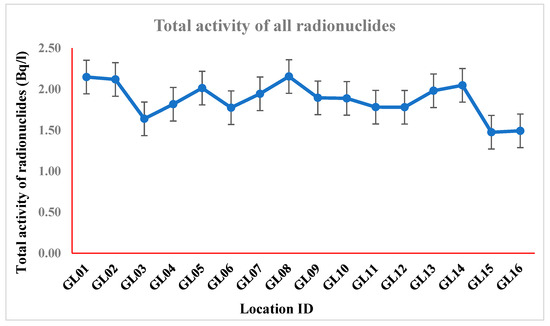
Figure 5.
Total activity of all isotopes measured for each sampling location.
3.2. Activity Ratios and Characteristics of Groundwater Aquifer
To determine the origins and processes of radium transport from aquifer rocks into water, the groundwater’s Ra-228/Ra-226 activity ratio can serve as a useful proxy. Radium isotope activities and their ratio (Ra-228/Ra-226) are often correlated with the parent nuclide abundances (Th-232, U-238) in the aquifer rocks. This relationship is influenced by the equilibrium states of the individual parent–daughter pairs within the rocks, the duration of groundwater contact with the rock, and the timing of water sampling [1].
In this study, the estimated activity ratios, as shown in Figure 6, were higher than 1, ranging between 2.37 and 6.08, with a mean of 3.70. Isotopic ratios exceeding 1 indicate that the source of high Ra-228 in the groundwater resources is of natural origin [11,36]. Therefore, the composition of Ra-228 in the aquifer rocks underlying the study area’s groundwater is at high levels. This characteristic of the groundwater aquifer suggests that, while groundwater can be an alternative water source for inhabitants, it might not be the best option due to the high concentration of naturally occurring radionuclides in the aquifer rocks.
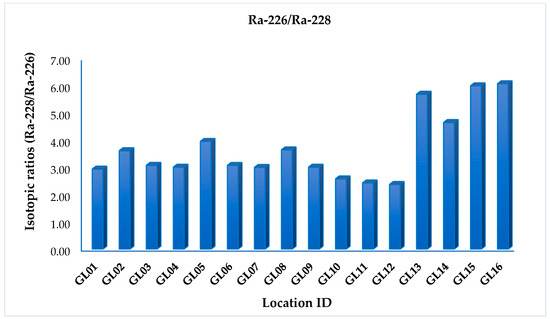
Figure 6.
Activity ratios of Ra-228/Ra-226 in the groundwater samples.
The groundwater of the Atiwa West district interacts with rocks of the Volta Basin hydrogeological formation, known as the Voltaian aquifer. This aquifer mainly consists of Precambrian to Paleozoic sandstones, shales, and conglomerates. The Volta Basin, located in West Africa, occupies about 40% of Ghana, covering an area of approximately 103,600 km² [15,16,17,37]. In parts of the study area, the Voltaian strata overlie the Birimian rocks, composed of sandstones, schist, and phyllites [17]. Gumma and Pavelic was noted that the Precambrian to Paleozoic basement complexes have poor groundwater potential, with a yield rate of 72 l/min [37]. This is likely due to steep hills in some parts of the study area, causing high runoff and low groundwater recharge rates. They also observed that areas with low runoff are generally good recharge zones, whereas areas with high runoff are poor recharge zones, with high drainage density and lower groundwater potential [37]. The Voltaian aquifer has a low groundwater residence time and is prone to chemical weathering [17]. Additionally, the presence of fractures in the aquifers can increase the rate of radionuclides leaching into the groundwater system as groundwater moves through these fractures containing radionuclides [17,23].
The isotopic ratio results from this study are comparable to findings from similar studies in other countries with akin aquifer rock characteristics. Shabana and Kinsara from Saudi Arabia and Sherif and Sturchio from Egypt studied radionuclide concentrations in groundwater samples from geological areas with sandstone aquifers. They recorded high Ra-228 concentrations, with mean isotopic ratios of 1.59 and 2.95, respectively [1,7]. Kiro et al. (2015) investigated radon and radium isotopes in Israel’s groundwater and found that areas with sandstone aquifers had higher Th/U activity ratios and consequently higher Ra-228/Ra-226 isotopic ratios greater than 1, compared to other aquifer rocks [36].
Pearson and Spearman correlations were used to evaluate the relationship between the activity concentrations of Ra-228 and Ra-226 in the Atiwa West groundwater. These correlations showed a lack of association between Ra-228 and Ra-226 activities (r = 0.04 for Pearson and r = 0.07 for Spearman). Figure 7 displays a very weak correlation coefficient (R² = 0.01) between the activities of Ra-228 and Ra-226 in the groundwater samples. Conversely, a p-value of 0.75 suggests a likely uniform distribution of radionuclides in the aquifer rocks of the study area [33].
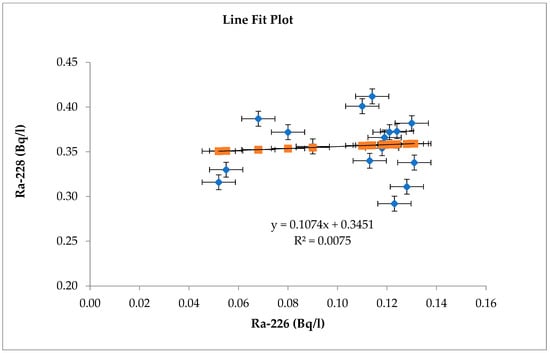
Figure 7.
Regression analysis between Ra-226 and Ra-228 in groundwater.
3.3. Groundwater Quality for Drinking Purpose and Dose Estimation
The demand for clean and potable drinking water is increasing due to the rising number of artisanal mining activities in the area. These mining activities have led to the pollution of surface waters, which are the primary source of water treatment by the Ghana Water Company. This pollution has resulted in higher water treatment costs and limited water supply to inhabitants of these areas [18]. Consequently, people are turning to wells and boreholes for their daily water needs. Surface waters are also used for irrigation, industrial purposes, and building construction, making groundwater quality an important consideration in this study due to pollution from mining activities.
Natural radioactivity levels in groundwater resources are crucial in evaluating water quality. The presence of radionuclides, particularly Ra, in groundwater can significantly increase human radiation exposure [1,9]. These radionuclides pose potential health hazards to the local population upon ingestion. Ghana has not established national reference levels for specific radionuclides in drinking water and relies on values recommended by international agencies like UNSCEAR and WHO, recognized for dose and health risk assessment. The evaluation of Atiwa West’s groundwater quality was based on UNSCEAR and WHO recommendations for committed effective dose calculation [13,29]. The assessment involved estimating the committed effective dose due to the ingestion of Ra-226, Ra-228, and K-40 in groundwater samples based on their activity concentrations and dose conversion factors.
Committed effective doses were calculated for three different age groups in the Atiwa West district across all sampled locations. These age groups, as defined by UNSCEAR [13], were infants (1–2 years old), children (7–12 years old), and adults (>17 years old). The effective doses for these groups, according to their annual groundwater consumption, are shown in Figure 8. For adults, the effective dose ranged from 0.17 to 0.24 mSv/year, with a mean value of 0.21 mSv/year. For children, the range was 0.44 mSv/year to 0.60 mSv/year (mean = 0.52 mSv/year), and for infants, it was 0.46 mSv/year to 0.63 mSv/year (mean = 0.55 mSv/year). These estimated doses were above the ICRP and WHO recommendations of 0.1 mSv/year by WHO and ICRP. While the adult group’s mean value of 0.21 mSv/year was below the UNSCEAR reference level of 0.3 mSv/year, the mean effective doses for infants and children, 0.55 mSv/year and 0.52 mSv/year, respectively, were above the UNSCEAR guideline level [13]. These estimates, exceeding 0.3 mSv/year, indicate that infants and children are more susceptible to health risks associated with the ingestion of radionuclides if they consume such groundwater resources.
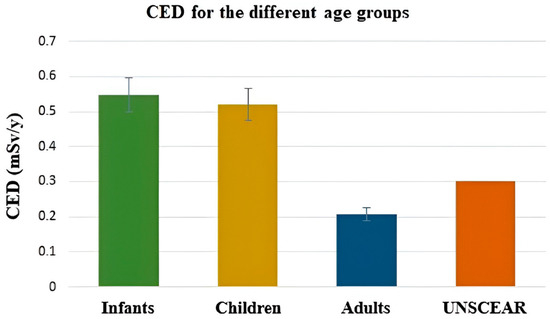
Figure 8.
The committed effective dose due to ingestion of such groundwater by the different age groups.
It was noted that the high dose rates, particularly for infants and children, could be attributed to the high Ra-228 activity concentrations in the water samples and its large dose-conversion factor (6.9 × 10−4 mSv/Bq). Additionally, the committed effective dose for infants and children was calculated using their respective annual water consumption rates of 250 L and 350 L. Due to their smaller body sizes, children and infants generally have higher committed effective doses compared to adults [9]. The order of the calculated committed effective dose was infants > children > adults.
The lifetime risk was assessed using the committed effective doses for adults. The average lifetime risk resulting from the consumption of Ra-226, Ra-228, and K-40 in groundwater ranged from 0.89 × 10−3 to 1.22 × 10−3, with a mean value of 1.06 × 10−3 across the study area. This value exceeds the upper bound reference level of approximately 10−4 for the lifetime risk of stochastic health effects. Given that the estimated effective doses were above the ICRP’s 0.1 mSv/year reference level, it was anticipated that the evaluated lifetime risk would exceed the recommended upper bound of 10−4 [30]. This indicates that consuming groundwater from the study area poses a risk of cancer development within the inhabitants’ lifetime, along with the possibility of severe hereditary effects by the end of their lifespan [29].
This study reveals that the concentrations of natural radionuclides in Atiwa’s groundwater resources are above the recommended guideline levels for consumption. The high activity concentrations of the measured radionuclides, and consequently the high committed effective doses and lifetime cancer risk factors, can be attributed to several factors. Activity ratios indicated that the aquifer rocks beneath the groundwater resources of the study area contain high levels of the thorium parent radionuclide. However, indiscriminate mining activities exacerbate the issue [11,38,39,40,41]. The crude gold mining methods observed during the investigations expose miners, the public, and the environment, including groundwater resources, to elevated levels of radioactivity and subsequent radiation doses [38]. In Ghana, artisanal and small-scale mining, often lacking strict regulatory control, leads to pollution, poor water quality, health problems, and increased threats to ecosystems [39]. Mining activities are not regulated for naturally occurring radionuclide exposures [40], raising concerns about the condition of surface and groundwater in mining communities [39,41]. Mining increases radionuclide levels in groundwater due to leaching from rocks, soil, and tailings [42,43]. Additionally, if a mining site is located in a significant groundwater recharge area, the backfill material can affect recharge characteristics, reducing infiltration rates due to the destruction of micropores and soil structure [44]. The reliance on such untreated groundwater for drinking and domestic use, as in Atiwa West, is detrimental to health [38]. Therefore, identifying, quantifying, evaluating, and managing such risks is significant for the general well-being of the population in mining communities [43]. This study is important for determining the groundwater quality of the surveyed area to safeguard the health of infants, children, and adults.
4. Conclusions
Groundwater is widely used in Ghana, particularly in rural areas, for drinking and household purposes. This study aimed to provide groundwater quality information with a focus on natural radioactivity levels. Wells and boreholes from 16 different locations were sampled and analyzed. Activity concentrations of Ra-226, Ra-228, and K-40 ranged between 0.05 ± 0.03 and 0.13 ± 0.04 Bq/L, 0.29 ± 0.04 and 0.41 ± 0.06 Bq/L, and 1.09 ± 0.10 and 1.65 ± 0.09 Bq/L, respectively. The measured radionuclide activities for Ra-226 and K-40 were below the global guidelines for drinking water, except for Ra-228. The presence of Ra-228 activity concentrations was found to be higher than that of Ra-226 in the groundwater, associated with the geological conditions and the Voltaian aquifer type in the study area. A weak correlation was observed between the activity levels of Ra-226 and Ra-228.
Using the radioactivity concentrations, the committed effective dose was evaluated for three age groups: adults, children, and infants. The determined committed effective doses, in relation to the recommended WHO and ICRP guidelines, were found to exceed 0.1 mSv/year. However, they were lower than the UNSCEAR ingestion value of 0.3 mSv/year for adults. Ra-228 contributed to a higher radiation dose than Ra-226 due to the ingestion of groundwater, regardless of the location and age group. Children and infants, however, may suffer higher doses from drinking the same groundwater. Therefore, the radiological hazard associated with using groundwater from the study area was considered to pose significant radiation exposure to humans, primarily affecting infants and children, with the likelihood of developing cancer-related diseases by the end of their lifetime. Based on the data presented in this study, it is recommended that efficient water-treatment technology capable of removing radionuclides should be employed to treat groundwater before consumption.
Author Contributions
Conceptualization: E.O.A.-k., F.O., A.S. and T.K.; Methodology, E.O.A.-k., F.O, A.S., A.C., E.T.G., A.S. and T.K.; Validation: L.T.-L. and E.A.; Analysis and investigation, E.O.A.-k., A.C., L.T.-L. and A.S. Writing—original draft preparation: E.O.A.-k., F.O., A.S. and T.K. All authors have read and agreed to the published version of the manuscript.
Funding
This research received no external funding.
Data Availability Statement
All data are presented in this paper.
Conflicts of Interest
Author Eunice Amponsem was employed by the company Walulel Ghana Limited. The remaining authors declare that the research was con-ducted in the absence of any commercial or financial relationships that could be construed as a potential conflict of interest.
References
- Sherif, M.I.; Sturchio, N.C. Radionuclide geochemistry of groundwater in the Eastern Desert, Egypt. Appl. Geochem. 2018, 93, 69–80. [Google Scholar] [CrossRef]
- Fang, S.-C. Study on 14C dating analysis of deep groundwater resources on islands. J. Environ. Radioact. 2019, 208–209, 105994. [Google Scholar] [CrossRef] [PubMed]
- Baeza, A.; Salas, A.; Guillen, J.; Munoz-Serrano, A.; Ontalba-Salamanca, M.A.; Jimenez-Ramos, M.C. Removal of naturally occurring radionuclides from drinking water using a filter specifically designed for Drinking Water Treatment Plants. Chemosphere 2017, 167, 107–113. [Google Scholar] [CrossRef] [PubMed]
- Alomari, A.H.; Saleh, M.A.; Hashima, S.; Alsayaheen, A.; Abdeldin, I.; Abukashabeh, A. 238U and 232Th isotopes in groundwater of Jordan: Geological influence, water chemistry, and health impact. Radiat. Phys. Chem. 2020, 170, 108660. [Google Scholar] [CrossRef]
- Csondor, K.; Bajak, P.; Surbeck, H.; Izsak, B.; Horvath, A.; Vargha, M.; Eross, A. Transient nature of riverbank filtered drinking water supply systems—A new challenge of natural radioactivity assessment. J. Environ. Radioact. 2020, 211, 106072. [Google Scholar] [CrossRef] [PubMed]
- Erőss, A.; Csondor, K.; Izsák, B.; Vargha, M.; Horváth, A.; Pándics, T. Uranium in groundwater- The importance of hydraulic regime and groundwater flow system’s understanding. J. Environ. Radioact. 2018, 195, 90–96. [Google Scholar] [CrossRef] [PubMed]
- Shabana, E.I.; Kinsara, A.A. Radioactivity in the groundwater of a high background radiation area. J. Environ. Radioact. 2014, 137, 181–189. [Google Scholar] [CrossRef]
- Turhan, S.; Özcıtak, E.; Taskın, H.; Varinlioglu, A. Determination of natural radioactivity by gross alpha and beta measurements in ground water samples. Water Res. 2013, 47, 3103–3108. [Google Scholar] [CrossRef]
- Zhong, Q.; Wang, X.; Wang, Q.; Zhang, F.; Li, L.; Wang, Y.; Du, J. 222Rn, 210Pb and 210Po in coastal zone groundwater: Activities, geochemical behaviors, consideration of seawater intrusion effect, and the potential radiation human-health risk. Appl. Radiat. Isot. 2020, 166, 109386. [Google Scholar] [CrossRef]
- Örgün, Y.; Altınsoy, N.; Gültekin, A.H.; Karahan, G.; Celebi, N. Natural radioactivity levels in granitic plutons and groundwaters in Southeast part of Eskisehir, Turkey. Appl. Radiat. Isot. 2005, 63, 267–275. [Google Scholar] [CrossRef]
- Mathuthu, M.; Uushona, V.; Indongo, V. Radiological safety of groundwater around a uranium mine in Namibia. Phys. Chem. Eart. 2021, 122, 102915. [Google Scholar] [CrossRef]
- Akweetelela, A.; Kgabi, N.; Zivuku, M.; Mashauri, D. Environmental radioactivity of groundwater and sediments in the Kuiseb and Okavango-Omatako basins in Namibia. Phys. Chem. Eart. 2020, 120, 102911. [Google Scholar] [CrossRef]
- UNSCEAR. Sources and Effects of Ionizing Radiation: Sources; United Nations Publications: New York, NY, USA, 2000; Volume 1. [Google Scholar]
- Selvi, B.; Vijayakumar, B.; Rana, B.; Ravi, P. Distribution of natural uranium in groundwater around Kudankulam. Radiat. Prot. Environ. 2016, 39, 15–25. [Google Scholar] [CrossRef]
- Gordon, C.; Nukpezah, D.; Tweneboah-Lawson, E.; Ofori, B.D.; Yirenya-Tawiah, D.; Pabi, O.; Ayivor, J.S.; Koranteng, S.; Darko, D.; Mensah, A.M. West Africa—Water resources vulnerability using a multidimensional approach: Case study of Volta Basin. In Climate Vulnerability: Understanding and Addressing Threats to Essential Resources; Elsevier Inc.: Amsterdam, The Netherlands, 2013; pp. 283–309. [Google Scholar]
- Gampson, E.K.; Nartey, V.K.; Golow, A.A.; Akiti, T.T.; Sarfo, M.A.; Salifu, M.; Aidoo, F.; Fuseini, A.R. Physical and isotopic characteristics in peri-urban landscapes: A case study at the lower Volta River Basin, Ghana. Appl. Water Sci. 2017, 7, 729–744. [Google Scholar] [CrossRef]
- Yidana, S.M.; Banoeng-Yakubo, B.; Aliou, A.-S.; Akabzaa, T.M. Groundwater quality in some Voltaian and Birimian aquifers in northern Ghana- application of mulitvariate statistical methods and geographic information systems. Hydrol. Sci. 2012, 57, 1168–1183. [Google Scholar] [CrossRef]
- Bansah, K.J.; Dumakor-Dupey, N.K.; Kansake, B.A.; Assan, E.; Bekui, P. Socioeconomic and environmental assessment of informal artisanal and small-scale mining in Ghana. J. Cleaner Prod. 2018, 202, 465–475. [Google Scholar] [CrossRef]
- Snapir, B.; Simms, D.M.; Waine, T.W. Mapping the expansion of galamsey gold mines in the cocoa growing area of Ghana using optical remote sensing. Intl. J. Appl. Eart Obser. Geoinf. 2017, 58, 225–233. [Google Scholar] [CrossRef]
- Yankson, P.W.K.; Gough, K.V. Gold in Ghana: The effects of changes in large-scale mining on artisanal and small-scale mining (ASM). Extrac. Indust. Soc. 2019, 6, 120–128. [Google Scholar] [CrossRef]
- Patel, K.; Rogan, J.; Cuba, N.; Bebbington, A. Evaluating conflict surrounding mineral extraction in Ghana: Assessing the spatial interactions of large and small-scale mining. Extrac. Indust. Soc. 2016, 3, 450–463. [Google Scholar] [CrossRef]
- Klubi, E.; Abril, J.M.; Mantero, J.; García-Tenorio, R.; Nyarko, E. Environmental radioactivity and trace metals in surficial sediments from estuarine systems in Ghana (Equatorial Africa), impacted by artisanal gold-mining. J. Environ. Radioact. 2020, 218, 106260. [Google Scholar] [CrossRef]
- Giri, S.; Singh, G.; Jha, V.N. Evaluation of radionuclides in groundwater around proposed uranium mining sites in Bagjata and Banduhurang, Jharkhand (India). Radiationprotection 2011, 46, 39–57. [Google Scholar] [CrossRef][Green Version]
- MOFEP. Programme-Based Budget Estimates for 2019, Atiwa West District Assembly. Ministry of Finance, Composite Budget for 2019–2022. Available online: https://mofep.gov.gh/sites/default/files/composite-budget/2019/ER/Atiwa-West.pdf (accessed on 23 July 2023).
- Amponsah, A.; Nasare, L.I.; Tom-Dery, D.; Baatuuwie, B.N. Land cover changes of Atiwa Range Forest Reserve, a biodiversity hotspot in Ghana. Trees For. People 2022, 9, 100301. [Google Scholar] [CrossRef]
- GSS. Ghana Statistical Service (GSS) 2010 Population & Housing Census, District Analytical Report, Atiwa District, October 2014. Available online: https://www2.statsghana.gov.gh/docfiles/2010_District_Report/Eastern/ATIWA.pdf (accessed on 23 July 2023).
- NDPC. National Development Planning Commission (NDPC) 2019 Annual Progress Report on the Implementation of the District Medium Term Development Plan 2018–2021 of The Agenda for Jobs: Creating Prosperity and Equal Opportunity for All, 2018–2021, Atiwa West District Assembly, January 2020. Available online: https://ndpc.gov.gh/media/ER_Atiwa_West_APR_2019.pdf (accessed on 23 July 2023).
- Akuo-ko, E.O.; Adelikhah, M.; Amponsem, E.; Csordas, A.; Kovacs, T. Radiological assessment in beach sediment of coastline, Ghana. Heliyon 2023, 9, E16690. [Google Scholar] [CrossRef] [PubMed]
- WHO. Guidelines for Drinking Water Quality, 4th ed.; World Health Organization: Genewa, Switzerland, 2011; pp. 1–541. [Google Scholar]
- ICRP. Protection from potential exposures—Application to selected radiation sources. Ann. ICRP 1997, 27, 76. [Google Scholar]
- WHO. Guidelines for Drinking-Water Quality, 3rd ed.; World Health Organizatiom: Genewa, Switzerland, 2008; Volume 1. [Google Scholar]
- Avwiri, G.O.; Osimobi, J.C.; Agbalagba, E.O. Evaluation of natural occurring radionuclide variation with lithology depth profile of Udi and Ezeagu local government areas of Enugu State, Nigeria. Int. J. Engin. Appl. Sci. 2013, 4, 1–10. [Google Scholar]
- Ravisankar, R.; Chandramohan, J.; Chandrasekaran, A.; Jebakumar, J.P.P.; Vijayalakshmi, I.; Vijayagopal, P.; Venkatraman, B. Assessments of radioactivity concentration of natural radionuclides and radiological hazard indices in sediment samples from the East coast of Tamilnadu, India with statistical approach. Mar. Pollut. Bull. 2015, 97, 419–430. [Google Scholar] [CrossRef] [PubMed]
- Yehia, M.; Baghdady, A.; Howari, F.M.; Awad, S.; Gad, A. Natural radioactivity and groundwater quality assessment in the northern area of the Western Desert of Egypt. J. Hydrol. Reg. Stud. 2017, 12, 331–344. [Google Scholar] [CrossRef]
- Hakam, O.K.; Choukri, A.; Reyss, J.L.; Lferde, M. Determination and comparison of uranium and radium isotopes activities and activity ratios in samples from some natural water sources in Morocco. J. Environ. Radioact. 2001, 57, 175–189. [Google Scholar] [CrossRef] [PubMed]
- Kiro, Y.; Weinstein, Y.; Starinsky, A.; Yechieli, Y. Application of radon and radium isotopes to groundwater flow dynamics: An example from the Dead Sea. Chem. Geol. 2015, 411, 155–171. [Google Scholar] [CrossRef]
- Gumma, M.K.; Pavelic, P. Mapping of groundwater potential zones across Ghana using remote sensing, geographic information systems, and spatial modeling. Environ. Monit. Assess. 2012, 185, 3561–3579. [Google Scholar] [CrossRef]
- Bello, S.; Nasiru, R.; Garba, N.N.; Adeyemo, D.J. Evaluation of the activity concentration of 40K, 226Ra and 232Th in soil and associated radiological parameters of Shanono and Bagwai artisanal gold mining areas, Kano State, Nigeria. J. Appl. Sci. Environ. Manag. 2019, 23, 1655–1659. [Google Scholar] [CrossRef]
- Attiogbe, F.K.; Mohammed, A.R.; Kingslove, Q. Assessing the potential health impact of selected heavy metals that pollute Lake Amponsah in Bibiani, Western North region, Ghana. Scient. Afr. 2020, 9, e00531. [Google Scholar] [CrossRef]
- Faanu, A.; Adukpo, O.K.; Kansaana, C.; Tettey-Larbi, L.; Lawluvi, H.; Kpeglo, D.O.; Darko, E.O.; Emi-reynolds, G.; Awudu, R.A.; Amoah, P.A.; et al. Impact assessment of naturally occurring radioactive materials on the public from gold mining and processing at Newmont Golden Ridge Limited, Akyem, Eastern region of Ghana. Radiat. Prot. Environ. 2016, 39, 155–164. [Google Scholar] [CrossRef]
- Olise, F.; Akinnagbe, D.M.; Olasogba, O.S. Radionuclides and radon levels in soil and groundwater from solid minerals-hosted area, South- Western Nigeria. Cog. Environ. Sci. 2016, 2, 1142344. [Google Scholar] [CrossRef]
- Galhardi, J.A.; García-Tenorio, R.; Bonotto, D.M.; Frances, I.D.; Motta, J.G. Natural radionuclides in plants, soils and sediments affected by U-rich coal mining activities in Brazil. J. Environ. Radioact. 2017, 177, 37–47. [Google Scholar] [CrossRef] [PubMed]
- Alazemi, N.; Bajoga, A.D.; Bradley, D.A.; Regan, P.H.; Shams, H. Soil radioactivity levels, radiological maps and risk assessment for the state of Kuwait. Chemosphere 2016, 154, 55–62. [Google Scholar] [CrossRef] [PubMed]
- Raghavendran, S.; Deka, P.C. Sustainable development and management of groundwater resources in mining affected areas: A review. Procedia Eart. Planet. Sci. 2015, 11, 598–604. [Google Scholar] [CrossRef]
Disclaimer/Publisher’s Note: The statements, opinions and data contained in all publications are solely those of the individual author(s) and contributor(s) and not of MDPI and/or the editor(s). MDPI and/or the editor(s) disclaim responsibility for any injury to people or property resulting from any ideas, methods, instructions or products referred to in the content. |
© 2023 by the authors. Licensee MDPI, Basel, Switzerland. This article is an open access article distributed under the terms and conditions of the Creative Commons Attribution (CC BY) license (https://creativecommons.org/licenses/by/4.0/).